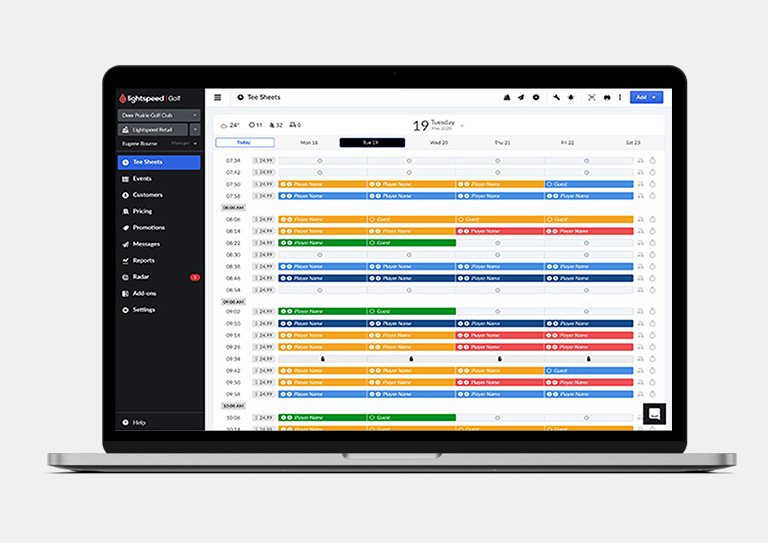A lateral hazard in golf is an area marked by red stakes or lines, running alongside the fairway. It poses a challenge by forcing players to drop the ball within two club lengths from the point of entry, with a one-stroke penalty.
Golf courses are designed with various challenges, and lateral hazards are one of them. These hazards run parallel to the fairway and can be water bodies, thick vegetation, or other obstacles. Lateral hazards add complexity and strategy to the game, requiring players to carefully plan their shots.
Knowing how to navigate these hazards effectively can significantly impact a player’s score. Players must understand the rules associated with lateral hazards to avoid unnecessary penalties. Mastering this aspect of the game can lead to better performance and more enjoyable rounds.
Contents
Types Of Lateral Hazards
Understanding the different types of lateral hazards in golf can improve your game. Lateral hazards can pose a challenge, but they also make the game more exciting. Let’s explore the most common types of lateral hazards you may encounter on the golf course.
Water Hazards
Water hazards are one of the most common types of lateral hazards. They include lakes, ponds, rivers, and streams. These hazards are marked by red stakes or lines. If your ball lands in a water hazard, you have several options:
- Play the ball as it lies, if possible.
- Take a one-stroke penalty and drop the ball within two club lengths of where it crossed the hazard.
- Drop the ball behind the hazard, keeping the point where the ball last crossed between you and the hole.
Water hazards can be tricky, but knowing the rules can save you strokes.
Out Of Bounds
Out of bounds (OB) areas are another type of lateral hazard. These areas are usually marked by white stakes or lines. Out of bounds areas are off-limits, and hitting into them can be costly. If your ball goes out of bounds, you must:
- Take a one-stroke penalty.
- Return to the spot of your last shot.
- Play another ball from there.
Out of bounds penalties can add up quickly, so aim to keep your shots within the course boundaries.
Rules And Penalties
Understanding the rules and penalties associated with a lateral hazard in golf can help you improve your game. Knowing what to do when you encounter a lateral hazard can save you strokes and reduce frustration.
Drop Options
When your ball lands in a lateral hazard, you have several drop options to consider:
- Two Club-Lengths Relief: Drop the ball within two club-lengths of where the ball crossed the hazard boundary.
- Opposite Margin: Drop the ball within two club-lengths on the opposite side of the hazard, equidistant from the hole.
- Back on the Line: Drop the ball on a line extending from the hole through the point where the ball last crossed the hazard, as far back as you want.
- Replay the Shot: Return to the spot of the previous shot and play it again.
Stroke Penalties
Each drop option comes with a stroke penalty:
| Drop Option | Penalty |
|---|---|
| Two Club-Lengths Relief | One Stroke |
| Opposite Margin | One Stroke |
| Back on the Line | One Stroke |
| Replay the Shot | One Stroke |
Remember, understanding these rules and penalties can make your play more strategic and enjoyable. Keep practicing and stay informed to lower your scores.
Strategy For Dealing With Lateral Hazards
Facing a lateral hazard in golf can be intimidating. Yet, with the right strategy, you can tackle these tricky spots with confidence. By focusing on risk assessment and shot selection, you can turn potential pitfalls into opportunities for smart play.
Risk Assessment
Before making any decision, assess the risk involved. Identify the exact location of the hazard and consider how it affects your next shot. Use a yardage book or a GPS device for precise measurements. Evaluate the terrain around the hazard. Is it rough, sandy, or full of water? Each type of hazard demands a different approach.
Think about the potential penalties. A wrong move could cost you strokes. Weigh the risks and rewards. Sometimes, it’s better to play it safe rather than go for a high-risk shot. Consider the wind direction and speed. Wind can drastically alter the flight of your ball, adding another layer of complexity.
Shot Selection
Once you’ve assessed the risks, focus on your shot selection. Choose a club that gives you the best control. Accuracy is more important than distance here. Opt for a shorter club if it offers more precision.
Visualize your shot. See the path your ball should take to avoid the hazard. A clear mental picture helps execute the shot more effectively. Practice different types of shots. Low punch shots or high lofted shots can help navigate around or over hazards.
Stay calm and focused. Pressure can lead to mistakes. Take a deep breath and trust your skills. Commit to your shot. Hesitation can lead to poor execution. Make a decision and stick with it.
Here’s a quick table to summarize the steps:
| Step | Action |
|---|---|
| 1 | Identify the hazard |
| 2 | Evaluate the terrain |
| 3 | Consider penalties |
| 4 | Check wind conditions |
| 5 | Choose the right club |
| 6 | Visualize the shot |
| 7 | Stay calm and focused |
| 8 | Commit to the shot |
By following these steps, you can effectively manage lateral hazards and improve your game.
Famous Lateral Hazard Moments
Lateral hazards have been part of many memorable golf moments. These tricky obstacles often change the course of a game. Let’s explore some famous lateral hazard moments in golf.
Historical Examples
Some historical lateral hazard moments have become legendary. These events are still talked about today.
| Event | Year | Description |
|---|---|---|
| The Masters | 1986 | Jack Nicklaus avoided a lateral hazard to win his sixth green jacket. |
| U.S. Open | 1962 | Arnold Palmer faced a tricky lateral hazard but managed to stay in the game. |
Modern Instances
Modern golfers also face lateral hazards. These moments often make headlines and excite fans.
- Rory McIlroy – 2014 PGA Championship: McIlroy hit a ball near a lateral hazard but recovered brilliantly.
- Jordan Spieth – 2015 Masters: Spieth navigated a lateral hazard to secure his first green jacket.
Lateral hazards create dramatic and unforgettable moments. These famous instances highlight their impact on the game.
Equipment And Gear Considerations
Navigating a lateral hazard in golf requires the right equipment and gear. The right club and ball choices can improve your game. Let’s explore these considerations to enhance your golfing skills.
Club Selection
Choosing the correct club is crucial for dealing with lateral hazards. Different clubs offer various advantages based on the situation.
| Club Type | Usage |
|---|---|
| Woods | Great for long distances but less control near hazards. |
| Irons | Offer better control, ideal for precision shots. |
| Wedges | Perfect for short distances and high accuracy. |
| Hybrids | Combine distance and control, versatile around hazards. |
Ball Choices
Selecting the right golf ball can also impact your performance near lateral hazards. Different balls have varying characteristics.
- Distance Balls: Ideal for long shots, but less control.
- Control Balls: Provide better handling and precision.
- Spin Balls: Offer increased spin, beneficial for tricky shots.
Consider the ball’s compression rate. Higher compression balls are suited for faster swing speeds. Lower compression balls are better for slower swings.
Pro Tips For Handling Lateral Hazards
Dealing with lateral hazards in golf can be challenging, even for seasoned players. These hazards demand a mix of mental toughness and technical skill. Here are some pro tips to help you handle lateral hazards with confidence and precision.
Mental Approach
Stay calm and focused. Lateral hazards can rattle your nerves, but maintaining a calm demeanor is crucial. Visualize your shot and believe in your ability.
Assess the situation carefully. Take a moment to evaluate your options. Look at the position of the hazard and your potential landing areas.
Commit to your decision. Once you choose your approach, stick to it. Doubts can lead to poor execution.
Technique Advice
Choose the right club. Select a club that offers control and accuracy. Often, a shorter club can help you navigate tricky areas.
Adjust your stance. Position your feet to ensure stability. Open your stance slightly to allow for a controlled swing.
Focus on a smooth swing. A smooth, controlled swing reduces the risk of mishits. Keep your eye on the ball and aim for a clean contact.
| Pro Tip | Benefit |
|---|---|
| Stay calm and focused | Improves decision-making and execution |
| Assess the situation | Better understanding of options |
| Choose the right club | Enhanced control and precision |
| Adjust your stance | Increased stability |
| Focus on a smooth swing | Reduces risk of mishits |
Practice regularly. Spend time practicing shots from difficult lies. This helps build confidence and improve your technique.
Learn from experience. Every lateral hazard encounter is a learning opportunity. Reflect on your performance and identify areas for improvement.
Final Thoughts
Understanding a lateral hazard in golf can significantly improve your game. It helps you navigate the course more efficiently and avoid unnecessary penalties. Here are some final thoughts to help you master this crucial aspect of golf.
Importance Of Course Management
Course management is key to reducing your score. Knowing how to handle lateral hazards can save you strokes.
- Plan your shots to avoid lateral hazards.
- Use the right club to ensure you steer clear of trouble.
Effective course management involves making smart decisions. These decisions should limit your risk and maximize your scoring opportunities.
Continuous Improvement
Continuous improvement in golf is essential. Focus on learning from your mistakes and improving your strategies.
- Review your rounds and identify areas for improvement.
- Practice specific shots that you struggle with.
- Seek advice from more experienced golfers or instructors.
By consistently working on your game, you can become more confident. This confidence will help you better manage lateral hazards.
| Strategy | Benefit |
|---|---|
| Avoiding Hazards | Reduces penalties and lowers your score |
| Smart Club Selection | Increases your chances of successful shots |
| Review and Practice | Helps you learn and improve continuously |
Implement these strategies for better results on the golf course.
Frequently Asked Questions
How To Play A Lateral Hazard In Golf?
To play a lateral hazard in golf, drop a ball within two club lengths from the point of entry. Ensure it’s no closer to the hole. You can also replay from the original spot or drop on the opposite margin, equidistant from the hole.
Penalty: one stroke.
How Many Strokes Is A Lateral Hazard?
A lateral hazard penalty in golf costs one stroke. Drop the ball within two club lengths from where it crossed the hazard.
Where Do I Drop From A Lateral Water Hazard?
Drop within two club-lengths from the point where the ball last crossed the hazard. Ensure no closer to the hole.
How Do You Take Relief From A Lateral Hazard?
To take relief from a lateral hazard, drop a ball within two club-lengths of the point where it last crossed the hazard boundary, no nearer the hole. You can also drop on the opposite margin, equidistant from the hole. Add a one-stroke penalty.
Conclusion
Understanding lateral hazards in golf can enhance your game strategy and improve your score. Knowing how to handle these obstacles helps you play smarter. Always keep the rules in mind and practice frequently. This knowledge can make your golfing experience more enjoyable and successful.
Happy golfing!





